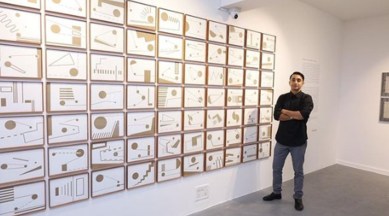📣 For more lifestyle news, click here to join our WhatsApp Channel and also follow us on Instagram
Artist Ankush Safaya’s latest exhibit asks questions about the remembered and the imagined
Safaya describes the exhibit as reflective, both for himself and the viewers

Thirty-seven-year-old Gurgaon-based artist Ankush Safaya’s latest exhibition, Memory Trace/Dapaan* (‘…it is said’) at Latitude 28, Delhi, is an assemblage of abstract mixed media work that defies linear meaning, inviting viewers to decode it as they wish. So a decisive starting point to describe Safaya’s work is likely to do injustice to it.
“Dapaan is a colloquial Kashmiri word, used frequently in everyday life, often used to begin any story that is fact or fiction. It is a space where the boundaries between the real and the imagined often blur” says Safaya, who grew up in Punjab’s Hoshiarpur but has roots in Kashmir. After the exodus began, his Kashmiri Pandit family migrated to Punjab, where his father had already been working.
monthly limit of free stories.
with an Express account.
At first glance, his art—all precise lines and geometrical arrangements—is the opposite of a blur. But as a viewer gets closer to the pieces, they see unsettlement brewing under the clear-cut shapes. Two-dimensional lines appear to have movement; patterns are interrupted by unique textures; even the papers that hold the work are layered onto each other as a palimpsest. “The conjuring of a visual tactility seduces the eye. My work is about the conflict, as it is about the calm” Safaya explains.
Memory Trace borrows from various influences, all embedded in Safaya’s experience. His training as an engineer opened up connections between technology and art. Circuit boards became Mondrian paintings, jumbled wires a Jackson Pollock masterpiece.
He also incorporates other articulations of memory in the form of historical and literary texts he has read. These are from geographies of conflict, using language to commemorate loss and connection. Safaya’s Kashmiri background, as well as his politics of preserving human life, make him particularly interested in such work. He selects passages from authors like Edward Said and Anton Chekhov, then translates them to Morse code so he can visually reinscribe them. One such technique involves using these codes to feed instructions into a laser, which then burns holes into his paper.
Safaya describes the exhibit as reflective, both for himself and the viewers. “It’s a process of looking at myself — both from the perspective of deconstructing a past that holds the imprint of my belonging, as well as imagining life as I am living it.” And in leaving his works untitled and open to interpretation, he provides a meditative space for viewers to reflect on the same thing. Memory Trace is home to carefully crafted art, but more than that, it is a call to examine the complex relationship between art, representation, and individual experience.
📣 For more lifestyle news, follow us on Instagram | Twitter | Facebook and don’t miss out on the latest updates!
📣 For more lifestyle news, click here to join our WhatsApp Channel and also follow us on Instagram